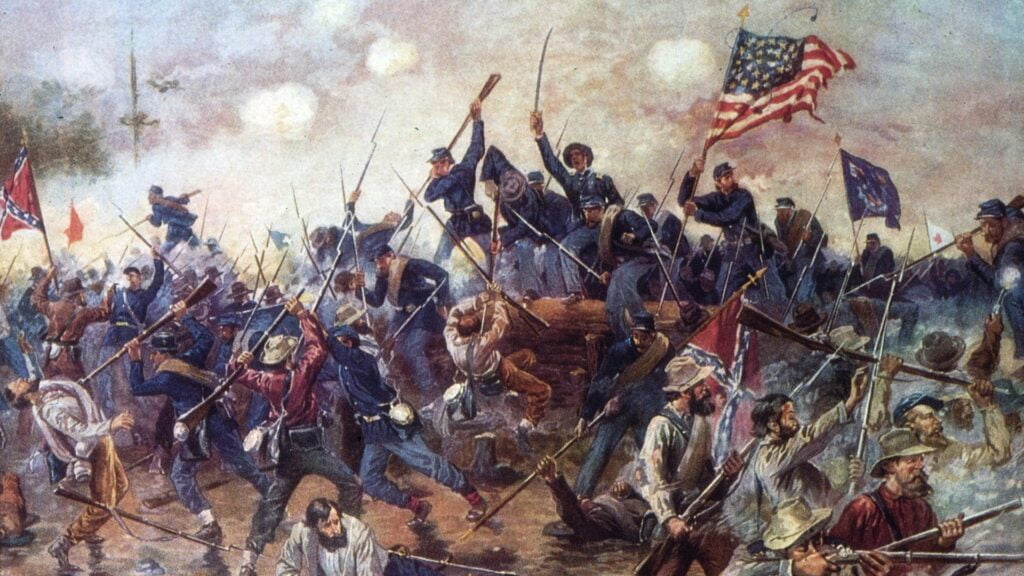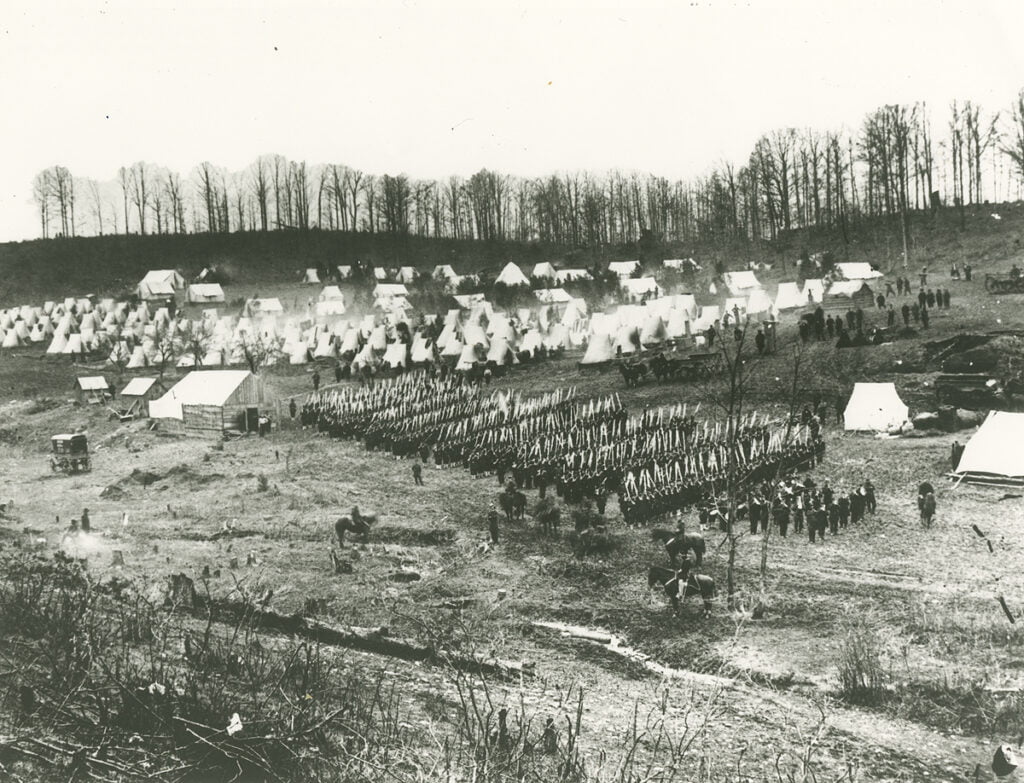The civil war: its causes, battles, and epoch.

Overview
The main historical event in American consciousness is the Civil War. Although the United States was founded during the Revolution of 1776–1783, the nature of the country was established during the Civil War of 1861–1865. Two fundamental issues that remained unanswered after the revolution were settled by the war were whether the United States would remain the world’s largest slaveholding nation despite its founding as an indivisible nation with an equal right to liberty or if it would dissolve into a confederation of sovereign states.
The institution of slavery, which had divided the country since its founding, was abolished as a result of the North’s victory in the war, maintaining the US as one nation. However, 625,000 American lives were lost in the process of achieving these goals—nearly as many as lost in all the previous conflicts this nation has participated in combined. Between the conclusion of the Wars of Napoleon in 1815 along with the start of the First World War in 1914, the Civil War in the United States constituted the biggest and most catastrophic war in the Western world.
Table of Contents
Causes of the Civil war
One popular theory is that the morality of slavery was the reason behind the Civil War. The crux of the conflict was, in fact, the political control over the slave system and its economics. States’ rights were a major concern.
In order to overturn federal laws they disagreed with, particularly those that restricted the South’s ability to own slaves and transport them wherever they pleased, the Southern states sought to establish their dominance over the federal government. Territorial expansion was another factor. While the North was determined to keep the western territories open to white labour alone, the South wanted to introduce slavery there. In the meantime, the recently established Republican party was becoming more well-known. Its members were adamantly against the spread of slavery to emerging western states.
The deal was sealed in 1860 when Abraham Lincoln, a Republican, was elected president. The fact that he won without receiving a single electoral vote from a Southern state sent a strong message to those states that they were no longer relevant. They felt shut out of the political system and resorted to what they thought was their only option: secession, a political act that sparked a war.

More on the reasons behind the Civil War from Wes.
Hardline disagreements between the states that practiced slavery and those that did not about the federal government’s authority to outlaw it in territories that were not yet states led to the outbreak of the Civil War. Seven southern slave states seceded to form the Confederate Nations of America, a new nation created when Abraham Lincoln, the first Republican president, was elected in 1860 on a platform promising to keep servitude out of the territories. The majority of Northerners and the newly elected Lincoln administration rejected the validity of secession. Their apprehension was that it would undermine democracy and establish a disastrous pattern that would ultimately split the once-mighty United States into multiple tiny, quarrelling nations.
Civil War’s outbreak (1861)
Confederate forces posed a threat to the federally organised Fort Sumter within Charleston, South Carolina, even after Lincoln took headquarters in March 1861. The Civil War began on April 12 when Confederate artillery fired its first shots, following Lincoln’s order for a fleet to resupply Sumter. After a bombardment lasting less than two days, Major Robert Anderson, the commander of Sumter, submitted, handing over control of the fort to Pierre G.T. Beauregard’s Confederate forces. Following Fort Sumter, Tennessee, North Carolina, Virginia, and Arkansas were the four additional southern states to ally with the Confederacy. Missouri, Kentucky, and Maryland—border states with slaves—did not secede, but their citizens harboured strong Confederate sympathies.
Although the 23 states of the Union had an important edge in population, manufacturing (which incorporates the production of weapons), and construction of railroads, the Confederates had a long history of military service and some of the best commanders and soldiers in the country. Despite this, the Civil War may have appeared to be an unfair struggle at first glance. They also supported the preservation of their long-standing customs and institutions, slavery foremost among them.
A larger number of the Union troops (or Federals) were compelled to flee towards Washington, D.C. by 35,000 Confederate soldiers led by Thomas Jonathan “Stonewall” Jackson in the initial battle of Bull Run, also known as First Manassas in the South, on July 21, 1861. This dashed hopes for a speedy Union victory and prompted Lincoln to request 500,000 more recruits. In actuality, after it became apparent that the conflict would not be a narrow or brief struggle, both sides were forced to expand their initial calls for troops.
Virginia’s Civil War (1862)
Lincoln was frustrated by George B. McClellan’s unwillingness to move forward, despite the fact that his troops adored him. McClellan had taken over as the Union Army’s supreme commander after the war’s early months, replacing the ageing General Winfield Scott. Finally, on May 4, 1862, McClellan’s Armed Forces of the Potomac crossed the York along with James Rivers to take Yorktown. This was in the early months of 1862.
During the Seven Days’ Battles (June 25–July 1), Robert E. Lee or Jackson’s combined forces successfully pushed McClellan’s army back, and a wary McClellan requested additional reinforcements before moving against Richmond. Lincoln declined and chose to withdraw the Potomac Army to Washington. Although McClellan was still in charge of the the military of the Potomac, Henry W. Halleck had taken over as the Union’s supreme leader by the middle of 1862.
After that, Lee divided his army and moved his troops northward, sending Jackson to confront Pope’s forces close to Manassas while he moved with the remaining half of the army on his own. In the second clash of Bull Run (also known as Second Manassas), Union forces under John Pope’s command attacked Jackson’s forces on August 29. Pope’s men were forced to retreat towards Washington the following day when Lee launched a massive assault on the Federal left flank.
Following his triumph at Manassas, Lee launched the Confederate assault of the North for the first time. In spite of conflicting directives from Halleck and Lincoln, McClellan managed to rearrange his forces and launch an attack on Lee on the 14th of September within Maryland, forcing the Confederates to retreat to an offensive position close to Sharpsburg along Antietam Creek.
The bloodiest day of fighting of the war occurred on September 17, when the troops of the Potomac attacked Lee’s forces, who had been reinforced by Jackson’s. Twelve,410 out of roughly 69,000 Union soldiers and 13,724 out of roughly 52,000 Confederate soldiers lost their lives in total during the Battle of Antietam, also known as the Combat of Sharpsburg. Lee was forced to flee into Virginia after the Union’s victory at Antietam stopped the Confederate grow in Maryland.
Nevertheless, Lincoln and Halleck despised McClellan for not pursuing his advantage, and they relieved him of his command and replaced it with Ambrose E. Burnside. Following Burnside’s assault on Lee’s forces close to Fredericksburg on December 13, which resulted in significant Union casualties along with a Confederate victory, Joseph “Fighting Joe” Hooker took over for Burnside, and both armies withdrew into winter quarters along the Rappahannock River.

Following the Proclamation of Emancipation (1863–4)
Lincoln issued an initial Emancipation Proclamation on January 1, 1863, which liberated all enslaved persons in the rebellious states, capitalizing on the Union’s victory at Antietam. He refuted his choice by citing it as a necessary wartime precaution, and he stopped short of freeing the slaves in the Union-aligned border states. Nevertheless, the Emancipation Proclamation forced the majority of the Confederacy’s labor force to defect, and it sharply shifted public opinion abroad in Favour of the Union. At the end of the Civil War in 1865, about 186,000 Black soldiers had enlisted in the Union Army, with 38,000 of them dying in combat.
Hooker’s strategies to launch a Union offensive in the early months of 1863 were derailed when the majority of Lee’s forces launched an unexpected attack on May 1. As a result, Hooker withdrew his men to Chancellorsville.
In the Civil War battle of Chancellorsville, the Union dropped 17,000 men (15 percent) while the Confederates won at a high cost, suffering 13,000 casualties (roughly 22 percent of their troops). In June, Lee launched a second invasion of the North, attacking Union forces under General George Meade on the July 1 in the southern Pennsylvanian town of Gettysburg. After three days of intense combat, the Confederates lost nearly sixty percent of their soldiers and were unable to break through the Union center.
The final Confederate assault of the North was put to an end when Meade failed to launch a counteroffensive and Lee’s remaining forces managed to flee into Virginia. The Battle of Vicksburg, which was won by Union forces led by Ulysses S. Grant in July 1863, was a pivotal moment in the war that occurred in the western theatre. Lincoln increased Grant’s authority following a Confederate victory in September currently Chickamauga Creek, which was located close to of Chattanooga, Tennessee. Grant subsequently commanded a reinforced Federal army, which included two corps from the Union Army of the Potomac, to triumph in the Battle of Chattanooga, which took place in late November.
In the Path of Union Triumph (1864-65)
Lincoln replaced Halleck in March 1864 and placed Grant in charge of the Union army. Grant moved to Washington and led the Army of the Potomac against Lee’s forces in northern Virginia, departing William Tecumseh Sherman as commander in the West. In May 1864, the Union suffered significant losses at the conflict of the Wilderness, at Spotsylvania, at Cold Harbour in early June, and at the crucial rail hub of Petersburg in June. However, Grant stuck to his attrition strategy and besieged Petersburg for a further nine months.
After outwitting the Confederates and taking Atlanta by September, Sherman and about 60,000 Union soldiers started the fabled “March to the Sea,” destroying Georgia and eventually taking the city of Savannah on the December 21. By mid-February, Sherman’s forces had taken control of Columbia as well as Charleston, South Carolina, and Jefferson Davis had finally given Lee the ultimate command, with the Confederate war campaign reaching its final stages. By mid-April, Sherman had advanced through North Carolina and taken control of Raleigh, Bentonville, Raleigh, Goldsboro, and Fayetteville.
Lee’s forces made a final stand of resistance on March 25, attacking and seizing the Federal-controlled Fort Stedman, while the Union was wearing thin from their siege of Petersburg and Richmond. However, a swift counterattack undid the victory, and Lee’s forces withdrew from Richmond on the evening of April 2-3. Grant and Meade followed the Confederates down the Appomattox River for the majority of the following week, ultimately running out of options for them to flee.
On April 9, at Appomattox Court House, Grant acknowledged Lee’s surrender. The great leader of the Union was killed on the eve of victory on April 14 at Ford’s Theatre in Washington, D.C. by actor and Confederate sympathizer John Wilkes Booth. On April 26, Johnston surrendered to Sherman at Durham Station, the state of North Carolina, thereby bringing the Civil War to an end.
Related Posts of Author
With US troops in the firing line, fears of a wider Middle East conflict are rising.
Crumbling the Israel-Gaza Clash




